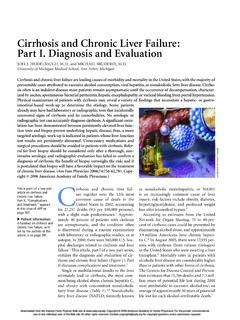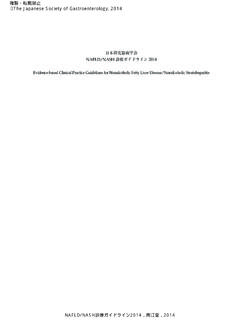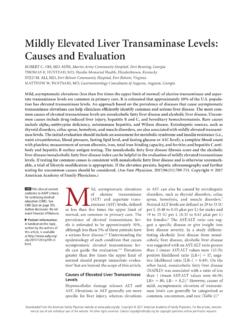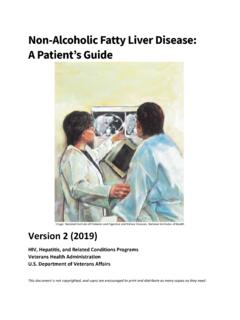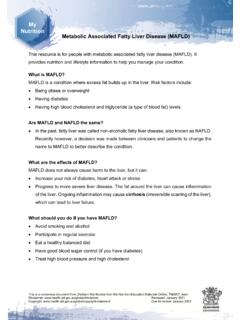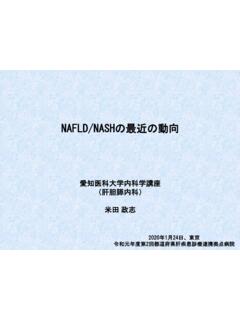Transcription of The Diagnosis and Management of Nonalcoholic Fatty Liver ...
1 The Diagnosis and Management ofNonalcoholic Fatty Liver disease :Practice Guidance From the AmericanAssociation for the Study ofLiver DiseasesNaga Chalasani,1 Zobair Younossi,2 Joel E. Lavine,3 Michael Charlton,4 Kenneth Cusi,5 Mary Rinella,6 Stephen A. Harrison,7 Elizabeth M. Brunt,8and Arun J. Sanyal9 PreambleThis guidance provides a data-supported approach tothe diagnostic, therapeutic, and preventive aspects ofnonalcoholic Fatty Liver disease ( nafld ) care. A Guidance document is different from a Guideline. Guidelinesare developed by a multidisciplinary panel ofexperts and rate the quality (level) of the evidence andthe strength of each recommendation using the GradingAbbreviations: AASLD, American Association for the Study of Liver Diseases; ACG, American College of Gastroenterology; AIH, autoimmune hepa-titis; ALT, alanine aminotransferase; APRI, AST to platelet ratio index; AST, aspartate aminotransferase; AUROC, area under the receiver operatingcurve; BMI, body mass index; CI, confidence interval; CLD, chronic Liver disease ; CT, computed tomography; CVD, cardiovascular disease ; ELF,Enhanced Liver Fibrosis; FDA, Food and Drug Administration; FIB-4, fibrosis-4 index; FLD, Fatty Liver disease ; GFR, glomerular filtrationrate; GLP-1, glucagon-like peptide-1; HCC, hepatocellular carcinoma; HCV, hepatitis C virus; HDL, high-density lipoprotein.
2 HF, hepatic fibrosis;HS, hepatic steatosis; ICD-10, International Classification of Diseases, Tenth Revision; IR, insulin resistance; LDL, low-density lipoprotein; LT, livertransplantation; METs, metabolic equivalents; MetS, MetS, metabolic syndrome; MR, magnetic resonance; MRE, MR elastography; MRI, magneticresonance imaging; NAFL, Nonalcoholic Fatty Liver ; nafld , Nonalcoholic Fatty Liver disease ; NAS, nafld activity score; NASH, Nonalcoholic fattyliver disease ; NASH CRN, NASH Clinical Research Network; NFS, nafld fibrosis score; NIAAA, National Institute on Alcohol Abuse and Alcohol-ism; OCA, obeticholic acid; PNPLA-3, patatin-like phospholipase domain-containing protein 3; PPAR, peroxisome proliferator-activated receptorgamma; RCT, randomized controlled trial; SAF, Steatosis Activity Fibrosis; SH, steatohepatitis; T2DM, type 2 diabetes mellitus; TE, transient elas-tography; TG, triglyceride; TONIC, treatment of Nonalcoholic Fatty Liver disease in children; UDCA, ursodeoxycholic acid; ULN, upper limit of normal;VCTE, vibration controlled transient elastography; WD, Wilson s June 29, 2017; accepted June 29, Supporting Information may be found funding for the development of this Practice Guidance was provided by the American Association for the Study of Liver practice guidance was approved by the American Association for the Study of Liver Diseases on June 15, by the American Association for the Study of Liver this article online at conflict of interest: Dr.
3 Chalasani consults for and received grants from Eli Lilly. He consults for NuSirt, AbbVie, Afimmune, Tobira,Madrigal, Shire, Cempra, Ardelyx, Axovant, and Amarin. He received grants from Intercept, Gilead, Galectin, and Cumberland. Dr. Younossi consultsfor Bristol-Myers Squibb, Gilead, Intercept, Allergan, and GlaxoSmithKline. He advises for Vertex and Janssen. Dr. Brunt advises for Gilead. consults for and received grants from Gilead, Intercept, NGM Bio, Genfit, and Novartis. He received grants from Conatus. Dr. Cusi consultsfor and received grants from Novo Nordisk. He consults for Tobira. He received grants from Cirius, Novartis, Janssen, Zydus, Nordic, and Lilly. consults for Intercept, Gilead, Genfit, Novartis, NGM Bio, and Nusirt. She advises for Fibrogen, Immuron, Enanta, and AbbVie. consults for Madrigal, NGM Bio, Genfit, Echosens, Prometheus, Cirius, Perspectum, and HistoIndex.
4 He advises for Garland, Intercept,Novartis, and Pfizer. He is on the speakers bureau for AbbVie, Gilead, and Alexion. Dr. Sanyal consults for and received grants from Salix, Conatus,Galectin, Gilead, malinckrodt, Echosens-Sandhill, Novartis, and Sequana. He consults for and is employed by Sanyal Bio. He consults for and ownsstock in GenFit, Hemoshear, Durect, and Indalo. He consults for Immuron, Intercept, Pfizer, Boehringer Ingleheim, Nimbus, Nitto Denko, Lilly, NovoNordisk, Fractyl, Allergan, Chemomab, Affimmune, Teva, and Ardelyx. He received grants from Bristol-Myers Squibb and Merck. He receivedroyalties from UptoDate. He owns stock in Exhalenz, Arkana, and NewCo GUIDANCE|HEPATOLOGY, VOL. 67, NO. 1, 2018 AHE STUDYOFLIVERD I S E ASESTMERICANASSOCIATIONFORof Recommendations, Assessment Development, andEvaluation system. Aguidancedocument is developedby a panel of experts in the topic, and guidance state-ments, not recommendations, are put forward to helpclinicians understand and implement the most Practice Guidance was commissioned by theAmerican Association for the Study of Liver Diseases(AASLD) and is an update to the Practice Guidelinepublished in 2012 in conjunction with the AmericanGastroenterology Association and the American Col-lege of Gastroenterology (ACG).
5 (1)Sections wherethere have been no notable newer publications are notmodified, so some paragraphs remain unchanged. Thisnarrative review and guidance statements are based onthe following: (1) a formal review and analysis of therecently published world literature on the topic (Med-line search up to August 2016); (2) the American Col-lege of Physicians Manual for Assessing Health Practicesand Designing Practice Guidelines(2); (3) guideline poli-cies of the AASLD; and (4) the experience of theauthors and independent reviewers with regard practice guidance is intended for use by physi-cians and other health professionals. As clinicallyappropriate, guidance statements should be tailoredfor individual patients. Specific guidance statementsare evidence based whenever possible, and, when suchevidence is not available or is inconsistent, guidancestatements are made based on the consensus opinionof the authors.
6 (3)This is a practice guidance for clini-cians rather than a review article, and interested read-ers can refer to several recent comprehensivereviews.(4-9)Because this guidance document islengthy, to make it easier for the reader, a list of allguidance statements and recommendations are pro-vided in a tabular form asSupporting Table defining nafld , there must be (1) evidence ofhepatic steatosis (HS), either by imaging or histology,and (2) lack of secondary causes of hepatic fat accumu-lation such as significant alcohol consumption, long-term use of a steatogenic medication, or monogenichereditary disorders (Table 1). In the majority ofpatients, nafld is commonly associated with meta-bolic comorbidities such as obesity, diabetes mellitus,and dyslipidemia. nafld can be categorized histo-logically into Nonalcoholic Fatty Liver (NAFL) or non-alcoholic steatohepatitis (NASH; Table 2).
7 NAFL isdefined as the presence of 5% HS without evidenceof hepatocellular injury in the form of hepatocyte bal-looning. NASH is defined as the presence of 5% HSand inflammation with hepatocyte injury ( , bal-looning), with or without any fibrosis. For defining advanced fibrosis, this guidance document will bereferring specifically to stages 3 or 4, that is, bridgingfibrosis or 1. Common Causes of Secondary HSMacrovesicular steatosis- Excessive alcohol consumption- Hepatitis C (genotype 3)-WD- Lipodystrophy- Starvation- Parenteral nutrition- Abetalipoproteinemia- Medications ( , mipomersen, lomitapide, amiodarone, methotrexate,tamoxifen, corticosteroids)Microvesicular steatosis- Reye s syndrome- Medications (valproate, antiretroviral medicines)- Acute Fatty Liver of pregnancy- HELLP syndrome- Inborn errors of metabolism ( , lecithin-cholesterol acyltransferasedeficiency, cholesterol ester storage disease , Wolman s disease )ARTICLE INFORMATION:From the1 Indiana University School of Medicine, Indianapolis, IN;2 Center for Liver disease and Department of Medicine, Inova FairfaxHospital, Falls Church, VA;3 Columbia University, New York, NY;4 University of Chicago, Chicago, IL;5 University of Florida,Gainesville, FL.
8 6 Northwestern University, Chicago, IL;7 Pinnacle Clinical Research, San Antonio, TX;8 Washington University School ofMedicine, St. Louis, MO;9 Virginia Commonwealth University, Richmond, CORRESPONDENCE AND REPRINT REQUESTS TO:Naga Chalasani, , FAASLDI ndiana University School of Medicine702 Rotary CircleSuite 225 Indianapolis, IN 46202E-mail: Vol. 67, No. 1, 2018 CHALASANI ET and Prevalence ofNAFLD in the GeneralPopulationINCIDENCE OF NAFLDT here is a paucity of data regarding the incidence ofNAFLD in the general population. A few studies havereported incidence of nafld from Asian countries,which are briefly summarized below: In a study that followed 11,448 subjects for 5years, incidence of nafld documented byultrasound was 12% (n51,418).(10) In a study of 635 Nagasaki atomic bomb survi-vors who were followed for years, incidenceof nafld documented by ultrasound was 1,000 person-years.
9 (11) In 565 subjects, the incidence of nafld at 3-5years, diagnosed using magnetic resonance (MR)imaging (MRI) and transient elastography (TE), wasestimated to be (34 per 1,000 person-years).(12) In a cohort study, 77,425 subjects free of NAFLDat baseline were followed for an average of During 348, person-years of follow-up,10,340 participants developed nafld docu-mented by ultrasound, translating to an incidencerate of per 1,000 person-years.(13)The incidence rates for nafld in the general pop-ulation of Western countries are even less commonlyreported: A study from England using International Classi-fication of Diseases, Tenth Revision (ICD-10)codes reported an incidence rate for nafld of29 per 100,000 person-years. Given the inaccu-racy of administrative coding such as ICD-10,this study most likely underestimates the trueincidence of nafld .
10 (14) A study from Israel reported an incidence rate of28 per 1,000 person-years.(15) A recent meta-analysis estimated that the pooledregional incidence of nafld from Asia to per 1,000 person-years (95% confidenceinterval [CI], ) whereas the incidencerate from the West is estimated to be around 28per 1,000 person-years (95% CI, ).(16)PREVALENCE OF NAFLDIn contrast to the incidence data, there is a signifi-cantly higher number of publications describing theprevalence of nafld in the general studies are summarized in a recent meta-analysis of the epidemiology of nafld : The meta-analysis estimated that the overallglobal prevalence of nafld diagnosed by imag-ing is around (95% CI, ).(16) The highest prevalence of nafld is reportedfrom the Middle East ( [95% CI, ]) and South America ( [95% CI, ]) whereas the lowest prevalencerate is reported from Africa ( [ ]).
